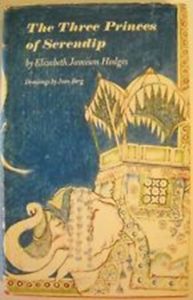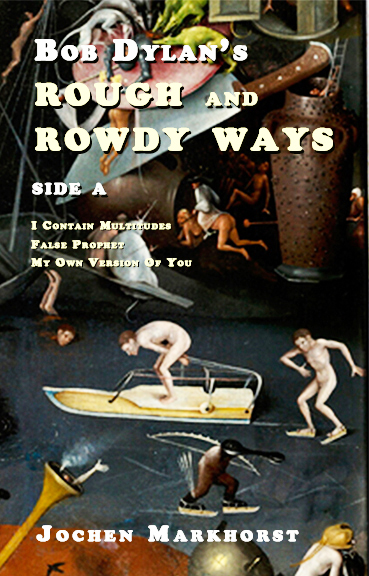by Jochen Markhorst
IV The Three Princes of Serendip
Well, when the pipeline gets broken and I'm lost on the river bridge I'm all cracked up on the highway and in the water's edge And then she comes down a thruway, ready to sew me up with a thread Well, if I go down dyin', you know she's bound to put a blanket on my bed
 The unreal intelligence and deductive powers of the most popular 21st-century Sherlock Holmes, Benedict Cumberbatch in the BBC series, cannot hold a candle to the acumen of a trio of princes. The Three Princes of Serendip is a 14th-century fairy tale that arrived in the Western world via an Italian translation in 1577. After their education, the king of Serendip (the old name for Sri Lanka) sends his sons out into the wide world, where the trio soon distinguish themselves through their exceptional wisdom, powers of observation and Sherlockian deductive abilities. Gnawed grass, tracks in the sand and the smell of a damp spot on the ground are enough: the brothers now know that the missing camel is lame, blind in one eye and missing a tooth, and has been led away by a pregnant woman. At lunch with the astonished Emperor, they deduce the type of soil in which the grapes for this wine were harvested, how the lamb from this leg of lamb was fed and, above all, thanks to a cunning ruse, they unmask a cowardly assassin who had targeted the Emperor.
The unreal intelligence and deductive powers of the most popular 21st-century Sherlock Holmes, Benedict Cumberbatch in the BBC series, cannot hold a candle to the acumen of a trio of princes. The Three Princes of Serendip is a 14th-century fairy tale that arrived in the Western world via an Italian translation in 1577. After their education, the king of Serendip (the old name for Sri Lanka) sends his sons out into the wide world, where the trio soon distinguish themselves through their exceptional wisdom, powers of observation and Sherlockian deductive abilities. Gnawed grass, tracks in the sand and the smell of a damp spot on the ground are enough: the brothers now know that the missing camel is lame, blind in one eye and missing a tooth, and has been led away by a pregnant woman. At lunch with the astonished Emperor, they deduce the type of soil in which the grapes for this wine were harvested, how the lamb from this leg of lamb was fed and, above all, thanks to a cunning ruse, they unmask a cowardly assassin who had targeted the Emperor.
In 1754, the name of the princes of Serendip inspired the English aristocrat Horace Walpole, who had apparently only read the story superficially (or in a poor translation), to coin the term serendipity: discovering something you did not know and therefore were not looking for, through chance, unintended circumstances. Just like in “that silly fairy tale of the three princes”, Walpole writes – incorrectly suggesting that the princes made their discoveries not through ingenuity, but through dumb luck. Thus, the origin of the wonderful concept of serendipity is itself a kind of serendipity.
Since then, it has become an elegant, melodious way of saying “lucky coincidence” or “happy accident”. The discovery of penicillin, the invention of Post-it notes, the microwave oven, Teflon, cornflakes and Viagra… serendipity.
We are familiar with the concept in poetry and songwriting as well: the unintended finds. Phil Collins doesn’t have any lyrics yet when he varies on Prince’s “1999” with his drum machine and his Roland TR-909 and just keeps ad-libbing the nonsensical “su-su-sudio” into the microphone – which turns out to be catchy enough to score a huge global hit (1985; “Sussudio” is number 1 on the Billboard Hot 100, scores Top 10 in fifteen countries and Top 20 in seven others). McCartney only has nonsensical filler lyrics for his “Hey Jude”. “It’s crazy, it doesn’t make any sense at all,” he says apologetically to Lennon as he sings the movement you need is on your shoulder. “Sure it does, it’s great,” says Lennon, who immediately recognises that Paul has accidentally come up with a completely original, thoroughly poetic way of expressing resignation, of shrugging your shoulders.
Phil Collins – Sussudio
Something similar seems to be happening in this second verse of “From A Buick 6”. The verse seems to be structured as an accumulatio, a list of equivalents that all try to communicate something like “burnt out, broken, desperate”. Without too much semantic density, once again: broken pipeline, all cracked up, in the water’s edge… not very eloquent, but at least it is clear that our narrator is at a mental low point. The images seem to have been selected primarily for their sound, euphony and rhyme. “Cracked”, for example, is a word that Dylan likes to use in these months (apart from here also in “Chimes Of Freedom”, “I Want You” and “To Ramona”). Pete Sinfield, the lyricist for King Crimson and a big Dylan fan, explains its power well when he traces why In The Court Of The Crimson King is such an appealing combination of words:
“What you have are the noises, the sounds of the words, like crowds, queue, jokers… ‘k’, ‘k’, ‘k’, do you see? You get this sharp cracking sound, and then it softens again…what is very important, even if you don’t pick up on it, is the feel of these hard sounds, even if you don’t understand the words, that there is something going on here – it was quite intentional to cause this effect – Bob Dylan admits to doing the same – it’s like playing games, but the games you play with the noises, the sounds and the syllables, and especially the consonants in this example, should keep the listener right there, suspended – it’s all in the way these are constructed.”
(2007 interview by Paul Henderson for Louder)
“The feel of these hard sounds” and “this sharp cracking sound, and then it softens again” is probably precisely what drove Dylan to choose word combinations such as the pipeline is broken and all cracked up on the highway. But then, between the “game playing with noises”, poetic brilliance suddenly shines through: lost on the river’s bridge.
Even in 1965, “bridge” was, of course, already a well-worn prop for clichéd metaphors. Crossing the bridge, burning your bridges, a bridge too far, building bridges… the age-old symbolic meaning of “bridge” is so obvious and so deeply ingrained in everyday language that we often no longer even recognise it as metaphorical. Except… except when a poet gives it such an unusual twist as “I’m lost on the river’s bridge”.
On its own, this unusual expression evokes uncomfortable, suicidal connotations. After all, it is impossible to get lost on a bridge, so we really have to think of being lost, despair – and a desperate person on a bridge… yes, then suicide is the most obvious scenario. Certainly, since 1967, since Billie Joe McAllister jumped off the Tallahatchie Bridge (“Ode To Billy Joe”, Bobbie Gentry), we have all been conditioned to think this way – but already before poor Billy Joe it was just as inevitable a line of thought.
However, here in “From A Buick 6” we have context. The wandering narrator oscillates between love and lust, between duty and pleasure, between the right bank with his graveyard woman, the mother of his children, and the left bank with the soulful mama – and is now apparently tormented by choice stress. Worse still: he has lost his mind. He stands on the bridge between one bank and the other and is lost. But luckily, one of the two ladies comes down a thruway and fixes him. Which lady is not made explicit, but she does it with needle and thread – which sounds domestic, which sounds like the graveyard woman. At least, that’s the most likely candidate. Given that in the songs in Dylan’s own jukebox a sewing lady usually stands for domesticity (Nina Simone’s “Be My Husband”, “Do-Re-Mi”, “Sleepy Time Gal”). And he himself will use it again thirteen years later (can you cook and sew, make flowers grow, “Is Your Love In Vain?”).
The only thing that is somewhat alienating is the embedding: she is ready to sew me up is still appropriate, we know that as “healing from emotional wounds”, but sew me up with a thread is usually said by guys like Jason Bourne or John Wick or Ethan Hunt, when they drag a shady doctor out of bed in the middle of the night to stitch up yet another bullet or stab wound – without anaesthetic, of course. On the other hand, our hero is, of course, cracked up, and he does have a broken pipeline. What a happy coincidence that his graveyard woman here on the bridge has a needle and thread with her. Well, serendipity, almost.
To be continued. Next up From A Buick part 5: You Can’t Judge A Book By The Cover
Jochen is a regular reviewer of Dylan’s work on Untold. His books, in English, Dutch and German, are available via Amazon both in paperback and on Kindle: 
- Blood on the Tracks: Dylan’s Masterpiece in Blue
- Blonde On Blonde: Bob Dylan’s mercurial masterpiece
- Where Are You Tonight? Bob Dylan’s hushed-up classic from 1978
- Desolation Row: Bob Dylan’s poetic letter from 1965
- Basement Tapes: Bob Dylan’s Summer of 1967
- Mississippi: Bob Dylan’s midlife masterpiece
- Bob Dylan’s Greatest Hits
- John Wesley Harding: Bob Dylan meets Kafka in Nashville
- Tombstone Blues b/w Jet Pilot: Dylan’s lookin’ for the fuse
- Street-Legal: Bob Dylan’s unpolished gem from 1978
- Bringing It All Back Home: Bob Dylan’s 2nd Big Bang
- Time Out Of Mind: The Rising of an Old Master
- Crossing The Rubicon: Dylan’s latter-day classic
- Nashville Skyline: Bob Dylan’s other type of music
- Nick Drake’s River Man: A very British Masterpiece
- I Contain Multitudes: Bob Dylan’s Account of the Long Strange Trip
- Bob Dylan’s Rough And Rowdy Ways – Side B
- Bob Dylan’s High Water (for Charley Patton)
- Bob Dylan’s 1971
- Like A Rolling Stone b/w Gates Of Eden: Bob Dylan kicks open the door
- It Takes A Lot To Laugh, It Takes A Train To Cry b/w Just Like Tom Thumb’s Blues – Bob Dylan’s melancholy blues
- Bob Dylan’s Rough And Rowdy Ways – Side A
